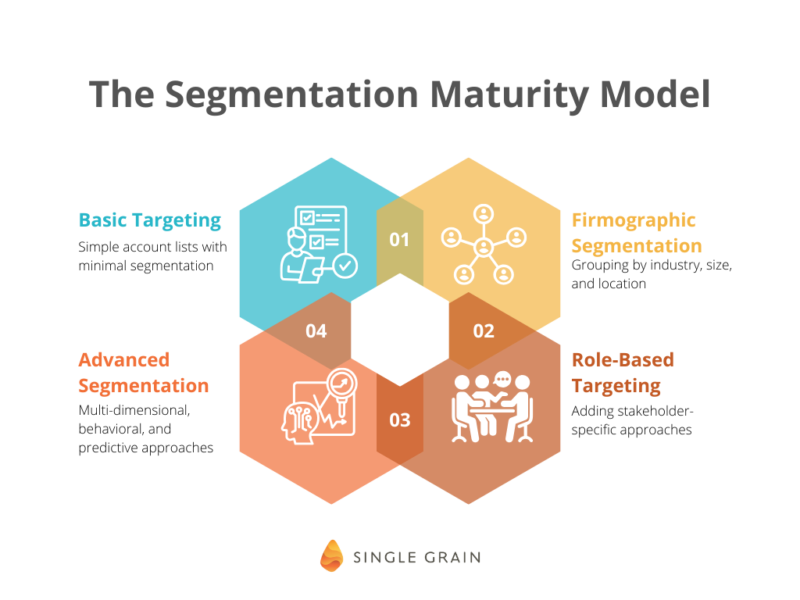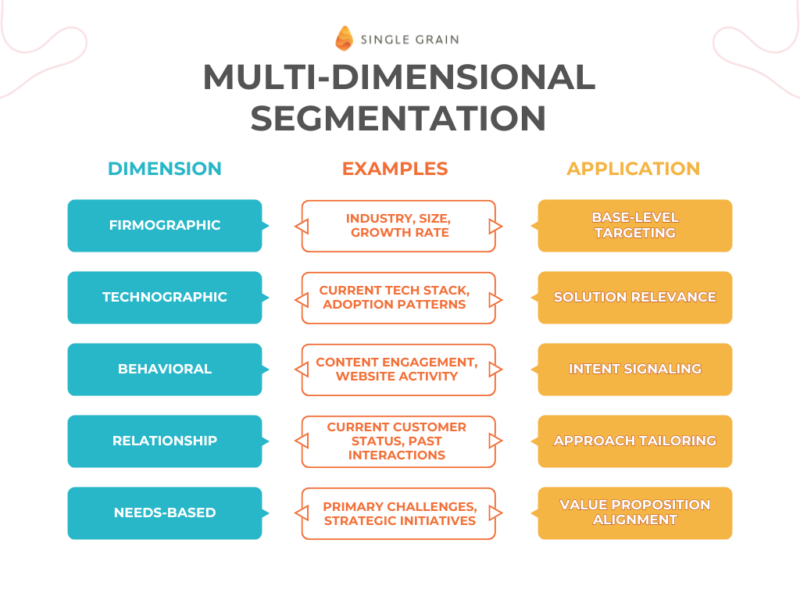Leveraging LinkedIn’s Data Insights: Advanced Segmentation Strategies for ABM
In the world of Account-Based Marketing (ABM), the quality of your targeting directly determines the effectiveness of your campaigns. While basic ABM approaches rely on simple firmographic data, advanced practitioners leverage LinkedIn’s rich data insights to implement sophisticated segmentation strategies that dramatically improve campaign performance.
LinkedIn’s professional network contains unparalleled data on companies, roles, skills, interests, and engagement patterns. By tapping into these insights, marketers can move beyond basic account lists to create highly targeted segments that enable relevant messaging and significantly improved results.
Key Highlights
- Advanced LinkedIn segmentation strategies can improve ABM campaign performance by up to 65%
- 97% of marketers report that ABM delivers a higher return on investment than other marketing strategies
- Multi-dimensional segmentation enables more relevant messaging and higher engagement rates
- Behavioral targeting based on LinkedIn activity provides powerful intent signals
- Lookalike modeling helps identify new high-potential accounts similar to current customers
- AI-powered tools like Karrot.ai can automate complex segmentation and personalization
- Integrated data approaches combine LinkedIn insights with first-party and third-party data
- Continuous refinement of segments based on performance data drives ongoing improvement
TABLE OF CONTENTS:
The Segmentation Evolution in LinkedIn ABM
Account-based marketing has transformed B2B marketing, with 70% of marketers now having active ABM programs. LinkedIn has emerged as the premier platform for ABM execution due to its professional focus and robust targeting capabilities.
However, the difference between average and exceptional LinkedIn ABM campaigns often lies in segmentation sophistication. Recent data shows that advanced LinkedIn segmentation strategies can improve ABM campaign performance by up to 65% compared to basic targeting approaches.
The Segmentation Maturity Model

LinkedIn ABM segmentation typically evolves through four stages of sophistication:
- Basic Targeting: Simple account lists with minimal segmentation
- Firmographic Segmentation: Grouping by industry, size, and location
- Role-Based Targeting: Adding stakeholder-specific approaches
- Advanced Segmentation: Multi-dimensional, behavioral, and predictive approaches
Organizations at the advanced stage report 68% higher account win rates than those using basic targeting approaches. This improvement stems from the increased relevance and precision that sophisticated segmentation enables.
The Advanced Segmentation Framework
Effective LinkedIn ABM requires a structured approach to segmentation:
Multi-Dimensional Segmentation
Implement segmentation across multiple dimensions:

This multi-dimensional approach ensures targeting considers all relevant factors rather than relying on simplistic criteria.
Segmentation Hierarchy
Develop a hierarchical approach to segment development:
Segmentation Hierarchy:
– Master Account List
– Industry Segments
– Company Size Tiers
– Stakeholder Roles
– Behavioral Segments
– Engagement Stages
This structured approach ensures segments are organized logically while enabling increasingly specific targeting.
Strategy 1: Leverage LinkedIn’s Native Segmentation Capabilities
LinkedIn offers powerful built-in segmentation capabilities:
Company Targeting Refinement
Optimize company targeting approaches:
- Industry targeting: 200+ industry classifications
- Company size: Employee count ranges for precise targeting
- Company growth rate: Target based on growth trajectory
- Company category: Public, private, non-profit, educational
- Company connections: Target based on connection relationships
This refined approach ensures company-level targeting is precise rather than overly broad.
Professional Attribute Targeting
Target based on professional characteristics:
- Job function: 26 job functions across departments
- Job seniority: 10 levels from entry to owner
- Job title: Thousands of standardized titles
- Skills: 35,000+ professional skills
- Groups: Thousands of professional interest groups
This professional targeting ensures you reach the right stakeholders within target accounts rather than broad company targeting.
Matched Audiences Optimization
Maximize the effectiveness of LinkedIn’s Matched Audiences:
- Account lists: Upload and segment company lists
- Contact lists: Target specific individuals within accounts
- Website retargeting: Segment based on site behavior
- Engagement retargeting: Target based on previous ad or content engagement
- Lookalike audiences: Expand reach to similar companies and professionals
Companies implementing comprehensive audience development strategies report 37% higher engagement rates compared to basic targeting approaches.
Strategy 2: Implement Behavioral Segmentation
Behavior-based segmentation significantly improves targeting relevance:
Engagement-Based Segmentation
Segment based on LinkedIn engagement patterns:
- Content engagement segments: Group by content interaction types
- Engagement recency segments: Categorize by timing of last interaction
- Engagement frequency segments: Segment by interaction volume
- Engagement depth segments: Differentiate by level of involvement
- Engagement progression segments: Group by pattern of interactions over time
This behavioral approach creates more relevant experiences than static segmentation, improving overall campaign performance.
Intent Signal Utilization
Leverage intent signals from LinkedIn activity:
- Content topic engagement: What subjects generate interest
- Competitor interaction: Engagement with competitive content
- Solution research: Interaction with solution-related content
- Event participation: Webinar and event attendance
- Career changes: Job changes and promotions
These intent signals help identify accounts in active buying cycles, significantly improving campaign timing and relevance.
The Karrot.ai Advantage
Platforms like Karrot.ai enhance behavioral segmentation through:
- AI-powered pattern recognition that identifies complex engagement signals
- Predictive intent modeling that forecasts buying readiness
- Automated segment creation based on behavioral clusters
- Dynamic segment updates as behaviors evolve
- Personalization automation based on behavioral insights
This AI-enhanced approach enables more sophisticated behavioral segmentation without proportional increases in time and resources.
Strategy 3: Develop Role-Based Segmentation
Different stakeholders require different messaging approaches:
Buying Committee Mapping
Map the complete buying committee within target accounts:
- Economic Buyers: Those who control budget and make final decisions
- Technical Evaluators: Those who assess solution capabilities
- End Users: Those who will use the solution day-to-day
- Influencers: Those who shape opinions but don’t make decisions
- Gatekeepers: Those who control access to other stakeholders
Organizations with a strong buying committee mapping approach achieve 68% higher account win rates by ensuring all decision-makers receive relevant messaging.
Role-Based Messaging Matrix
Develop a matrix of messaging approaches for different roles:
| Role | Primary Concerns | Value Proposition Focus | Content Types | Call-to-Action |
|---|---|---|---|---|
| C-Suite | Strategic impact, ROI | Business outcomes | Executive briefs, ROI studies | “See the strategic impact” |
| Directors | Operational efficiency, team impact | Workflow improvements | Case studies, implementation guides | “Discover implementation approach” |
| Managers | Feature functionality, integration | Practical capabilities | Product demos, technical guides | “See how it works” |
| End Users | Usability, daily benefits | Ease of use, time savings | Quick-start guides, feature overviews | “Experience the difference” |
This structured approach ensures messaging is systematically aligned with role-specific concerns rather than generically applied.
Sequential Role Targeting
Implement strategic sequencing of role targeting:
- Identify entry points: Which roles typically engage first
- Map influence patterns: How influence flows between roles
- Develop role sequences: Strategic order for engaging different stakeholders
- Create content journeys: Progressive content paths for each role
- Implement coordinated timing: Synchronized outreach across roles
This sequential approach ensures targeting aligns with natural buying processes rather than engaging all roles simultaneously.
Strategy 4: Utilize Technographic Segmentation
Technology stack data provides powerful targeting insights:
Technology-Based Targeting
Segment accounts based on their technology profile:
- Current technology usage: Target based on installed solutions
- Technology categories: Group by types of systems implemented
- Implementation timing: Target based on recent technology changes
- Technology gaps: Identify missing complementary solutions
- Integration opportunities: Target based on connection potential
This technographic approach ensures solution relevance based on the account’s actual technology environment.
Competitive Displacement Segmentation
Develop segments for competitive displacement:
- Competitor customer identification: Identify accounts using competitive solutions
- Renewal timing targeting: Target based on contract renewal windows
- Satisfaction-based segmentation: Target accounts showing dissatisfaction signals
- Feature gap targeting: Focus on accounts needing capabilities you offer
- Migration opportunity segmentation: Target accounts suitable for platform switching
This competitive approach focuses resources on accounts most likely to switch from competitors.
Technology Adoption Segmentation
Segment based on technology adoption patterns:
- Innovators/Early Adopters: Target forward-thinking organizations
- Early Majority: Focus on companies following initial adoption waves
- Late Majority: Target more conservative organizations
- Technology Laggards: Identify companies needing modernization
- Adoption Stage Mixing: Different adoption stages across technology categories
This adoption-based approach ensures messaging aligns with an organization’s technology adoption philosophy and current stage.
Strategy 5: Implement Predictive Segmentation
Advanced segmentation leverages predictive analytics:
Predictive Account Scoring
Implement a predictive account scoring model that incorporates multiple data points:
- Firmographic fit: Alignment with ideal customer profile
- Behavioral signals: Engagement patterns indicating interest
- Technographic alignment: Technology compatibility indicators
- Buying stage indicators: Signals of active purchasing processes
- Opportunity sizing: Potential deal value predictions
By weighting these factors based on their correlation with conversion likelihood, you can create a scientific account selection model that significantly outperforms intuition-based targeting.
Organizations using predictive account scoring report 68% higher account win rates than those using basic targeting approaches. This improvement stems from focusing resources on accounts with the highest statistical likelihood of conversion.
Lookalike Modeling
Leverage lookalike modeling to expand target account lists:
- Identify seed accounts: Your best customers or highest-value prospects
- Define similarity criteria: What attributes indicate similarity
- Set similarity thresholds: How closely matches should align
- Create expansion segments: Groups of similar or overlapping accounts
- Implement tiered approaches: Different strategies based on similarity scores
This expansion approach helps identify high-potential accounts that might be missed through traditional targeting methods.
AI-Powered Segmentation
Utilize artificial intelligence for advanced segmentation:
- Pattern recognition: Identifying complex relationships in data
- Cluster analysis: Grouping accounts based on multiple attributes
- Propensity modeling: Predicting likelihood of specific behaviors
- Natural language processing: Analyzing unstructured data for insights
- Continuous learning: Refining segments based on performance data
This AI-enhanced approach enables segmentation sophistication that would be impossible through manual methods alone.
Strategy 6: Integrate Multiple Data Sources
Combining LinkedIn data with other sources creates more powerful segmentation:
Data Integration Framework
Implement a comprehensive data integration approach:
Data Sources:
– LinkedIn Platform Data
– CRM Data
– Marketing Automation Data
– Website Behavior Data
– Intent Data Providers
– Technographic Data
This integrated approach ensures segmentation leverages all available insights rather than relying on isolated data sources.
First-Party Data Enhancement
Enrich LinkedIn targeting with your first-party data:
- CRM integration: Incorporate account history and status
- Marketing automation data: Include engagement patterns across channels
- Website behavior: Add browsing and interaction patterns
- Product usage data: Incorporate solution utilization insights
- Sales interaction history: Include conversation and meeting data
This enhancement ensures LinkedIn targeting benefits from your unique customer insights rather than generic targeting criteria.
Third-Party Data Augmentation
Supplement with specialized third-party data:
- Intent data: Purchase research signals from across the web
- Technographic data: Detailed technology stack information
- Financial data: Performance metrics and investment patterns
- News and events data: Trigger events and company developments
- Industry-specific data: Vertical-focused insights and indicators
This augmentation adds dimensions that aren’t available through LinkedIn or first-party data alone, creating more sophisticated targeting capabilities.
Strategy 7: Implement Dynamic Segmentation
Static segments quickly become outdated; dynamic approaches maintain relevance:
Trigger-Based Segmentation
Develop segments based on specific trigger events:
- Leadership changes: New executives or reorganizations
- Funding events: Investment rounds or budget approvals
- Growth indicators: Expansion, hiring surges, or new locations
- Technology changes: New implementations or stack changes
- Strategic shifts: New initiatives or business model changes
This trigger-based approach ensures targeting responds to significant account changes rather than relying on static information.
Engagement-Based Refinement
Continuously refine segments based on engagement:
- Monitor response patterns across different segments
- Identify high-performing segment characteristics
- Create refined segments based on engagement insights
- Implement progressive segmentation that evolves with interactions
- Develop engagement scoring models for automated refinement
This dynamic approach ensures segments evolve based on actual response data rather than remaining fixed despite performance evidence.
Automated Segment Management
Implement systems for automated segment maintenance:
- Regular data refreshes: Scheduled updates of segment data
- Automated recategorization: Rules-based segment reassignment
- Performance-based optimization: Adjustment based on results
- Decay modeling: Time-based relevance degradation
- Segment expansion/contraction: Size adjustment based on performance
This automation ensures segments remain current and effective without requiring constant manual maintenance.
Case Study: Tech Company Transforms Results with Advanced Segmentation
A B2B software company implemented sophisticated LinkedIn segmentation for their ABM program targeting 1,000 enterprise accounts. By moving beyond basic targeting, they:
- Developed a multi-dimensional segmentation model incorporating firmographic, technographic, and behavioral data
- Created role-based segments across 5 key stakeholder groups
- Implemented intent-based targeting using LinkedIn engagement signals
- Utilized Karrot.ai to automate personalization based on segment characteristics
- Integrated CRM and third-party intent data to enhance LinkedIn targeting
The results demonstrated the power of advanced segmentation:
- 187% increase in click-through rates compared to previous broad targeting
- 64% improvement in conversion rates across segments
- 42% reduction in cost-per-acquisition
- 3.2X increase in qualified opportunities
- $18.7M in influenced pipeline within 6 months
Best Practices for LinkedIn Segmentation Success
To maximize the effectiveness of your LinkedIn ABM segmentation, follow these proven best practices:
- Start with clear objectives that define what segmentation needs to accomplish
- Implement multi-dimensional approaches rather than single-factor segmentation
- Balance segment specificity with scale to ensure viable audience sizes
- Validate segments before full deployment through small-scale testing
- Develop segment-specific content strategies rather than generic messaging
- Implement regular performance analysis by segment
- Create a continuous refinement process based on response data
- Leverage AI-powered tools like Karrot.ai to enable sophisticated segmentation at scale
- Document segmentation frameworks to ensure consistent application
- Train marketing and sales teams on segment characteristics and approaches
Conclusion
Leveraging LinkedIn’s data insights for advanced segmentation represents one of the most significant opportunities for improving ABM performance. By implementing sophisticated segmentation strategies—from multi-dimensional and behavioral approaches to predictive and dynamic models—marketers can create significantly more relevant experiences for target accounts.
With 97% of marketers reporting that ABM delivers a higher ROI than other marketing strategies, investing in advanced segmentation is well justified. The key is moving beyond basic account lists to create genuinely insightful segments that enable relevant, personalized engagement.
As you implement these strategies for your LinkedIn ABM campaigns, consider how automation tools like Karrot.ai can help you implement and maintain sophisticated segmentation at scale. By combining LinkedIn’s rich data insights with AI-powered segmentation capabilities, you can create targeting approaches that deliver exceptional, measurable results for your business.




